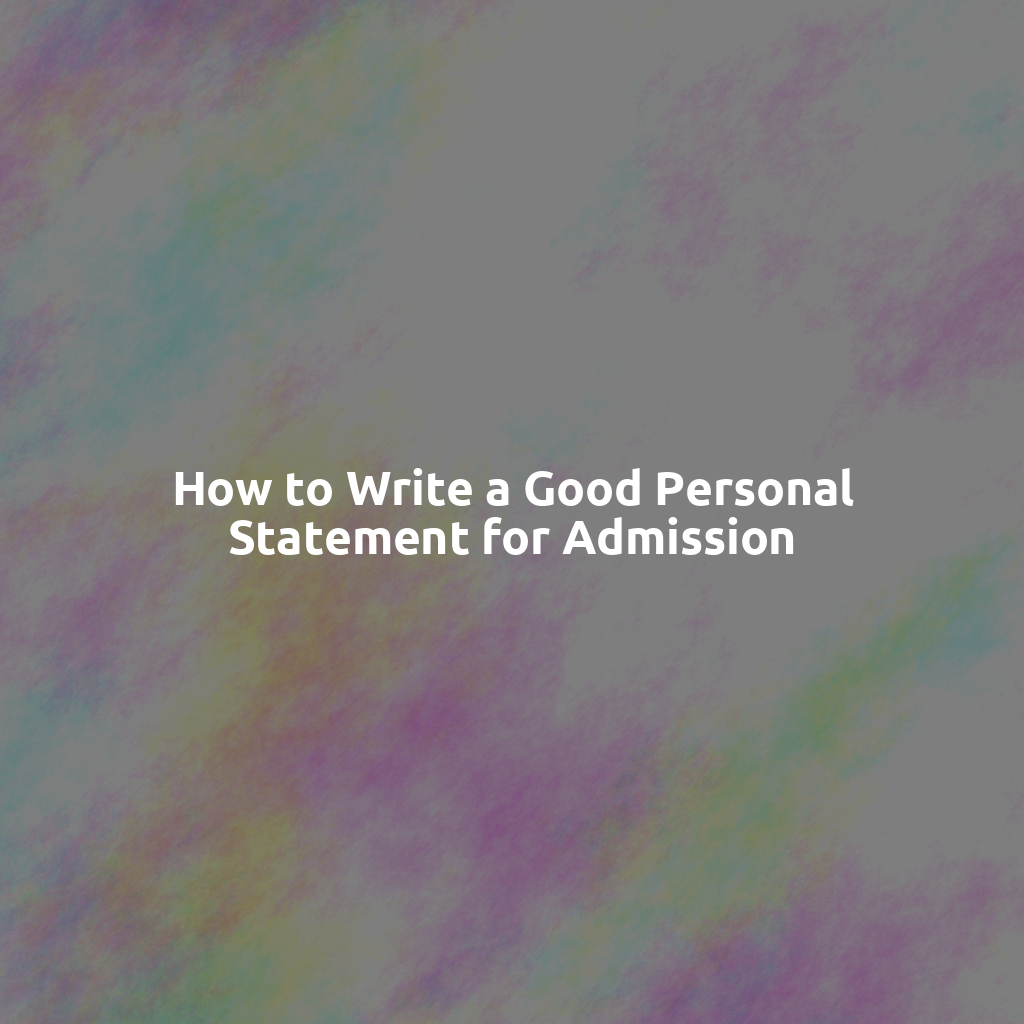Understanding the Purpose of a Personal Statement
Defining a Personal Statement
A personal statement conveys your personal and academic journey.
It provides insights into your motivations and goals.
Furthermore, it allows you to showcase your unique experiences.
The Role of a Personal Statement in Admissions
A personal statement plays a crucial role in the admissions process.
Admission committees use it to assess your candidacy.
Advertisements
It offers an opportunity to stand out among applicants.
Highlighting Your Strengths and Achievements
This document highlights your strengths and accomplishments.
You should emphasize significant milestones in your life.
Additionally, showcasing relevant skills enhances your profile.
Demonstrating Fit and Commitment
Your personal statement should demonstrate fit for the program.
Explain why you seek to pursue this field of study.
Moreover, express your passion and commitment to your goals.
Building a Narrative
A personal statement should tell your story effectively.
It should create a cohesive narrative about your journey.
Engaging storytelling captures the reader’s attention.
Identifying Core Themes and Personal Experiences to Highlight
Understanding Your Journey
Begin by reflecting on your personal journey.
Advertisements
Your experiences have shaped your aspirations.
Think about key moments that influenced your path.
These moments can serve as a foundation for your statement.
Choosing Relevant Themes
Select themes that resonate with your experiences.
Consider themes like resilience, passion, or growth.
Each theme should align with your goals.
For example, if you overcame challenges, highlight resilience.
Connecting Experiences to Goals
Your experiences should connect directly to your future aspirations.
Explain how specific events shaped your academic interests.
This connection shows your motivation for pursuing further education.
Indeed, clarity in these connections strengthens your statement.
Showcasing Unique Aspects
Highlight what makes you unique as a candidate.
Consider skills, perspectives, or experiences that stand out.
For instance, have you volunteered in diverse environments?
This can illustrate your adaptability and commitment.
Seeking Feedback
Once you draft your statement, seek feedback.
Ask mentors, friends, or family to review your work.
They can provide valuable insights and suggestions.
Overall, constructive criticism enhances your final submission.
Researching the Program and Institution to Tailor the Statement
Understanding Program Requirements
Begin your research by reviewing the program’s specific requirements.
Identify the key skills and experiences that the program values.
Take note of any unique aspects of the program that appeal to you.
Understanding these factors will shape your personal statement significantly.
Exploring Institutional Values
Next, delve into the institution’s values and mission statement.
Align your personal narrative with these core values.
This alignment demonstrates your fit within the academic community.
Moreover, it shows your commitment to contributing positively to the institution.
Investigating Faculty and Research Opportunities
Research the faculty members associated with the program.
Learn about their research interests and recent publications.
This knowledge allows you to highlight relevant connections in your statement.
Express your enthusiasm for contributing to their ongoing projects.
Connecting Personal Goals with Program Strengths
Reflect on how the program’s strengths can aid your personal and professional development.
Specify what you hope to achieve academically and personally.
Clearly articulate how the institution and program align with these aspirations.
This enhances the relevance of your personal statement and reinforces your motivation.
Utilizing Networking Opportunities
Leverage networking opportunities provided by the institution, such as open houses.
Engage with current students or alumni if possible.
These interactions can provide insights that may enrich your personal statement.
Furthermore, they help illustrate that you are proactive and invested in your application.
Finalizing Your Tailored Statement
After gathering all pertinent information, structure your statement accordingly.
When writing, ensure that each point reflects your research findings.
This tailored approach creates a compelling narrative about your fit for the program.
Review your statement several times to ensure clarity and relevance.
Structuring the Personal Statement
Your introduction should grab the reader’s attention immediately.
Start with a personal story or an impactful statement.
This is your chance to convey who you are.
Clearly outline your purpose for writing.
Make a connection to the program you’re applying for.
The body expands on your introduction’s themes.
Organize this section into clear and concise paragraphs.
Describe your academic background and achievements.
Include relevant experiences that shaped your goals.
Be specific about skills and qualifications you possess.
Discuss your motivations and aspirations for the future.
Link your past experiences to the program’s objectives.
Ensure a logical flow from one paragraph to the next.
Your conclusion succinctly summarizes your main points.
Reiterate your passion for the field of study.
Highlight how the program aligns with your goals.
Leave the reader with a final thought on your potential.
Thank the admission committee for their consideration.
Crafting a Compelling Narrative
Understanding Personal Growth
Your personal statement should begin with a genuine reflection on your growth.
Consider key experiences that shaped you into who you are today.
Highlight important moments that influenced your life direction.
For instance, a challenging situation can reveal your resilience.
Furthermore, growth comes from learning and overcoming obstacles.
Engaging Your Audience
Use vivid storytelling to draw the reader in.
Describe your journey in a relatable and engaging manner.
Incorporate emotions to create a deeper connection.
Transition smoothly between different phases of your life.
Consider including specific anecdotes that illustrate your points.
Reflecting on Your Values
Discuss how your experiences relate to your core values.
Explain why these values are significant in your journey.
Your values will guide your future decisions and ambitions.
Ensure the reader understands what drives and motivates you.
Ultimately, reflection highlights your character and integrity.
Connecting to Future Aspirations
Your personal statement should bridge your past with your future.
Explain how your experiences have prepared you for your next steps.
Clearly articulate your goals and ambitions moving forward.
For example, discuss how specific programs align with your career path.
This connection showcases your commitment to growth and learning.
Using Clear and Concise Language to Convey Your Message
Importance of Clarity
Clear language enhances understanding.
It allows the reader to grasp your key points quickly.
Furthermore, clarity reflects your ability to communicate effectively.
Avoiding Ambiguity
Avoid jargon and complex terms.
Use simple language that anyone can understand.
This practice improves your personal statement’s accessibility.
Choosing the Right Words
Select strong, precise words to express your ideas.
For instance, instead of “help,” use “assist” or “support.”
This specificity adds impact to your statements.
Maintaining Conciseness
Stay focused on your main message throughout the statement.
Each sentence should advance your narrative logically.
Remember, brevity is key to keeping the reader engaged.
Using Active Voice
Active voice makes your writing more dynamic.
It places emphasis on your actions and experiences.
For example, say “I lead a project” instead of “A project was led by me.”
Transition Words for Flow
Incorporate transition words to improve flow.
Words like “additionally,” “however,” and “consequently” guide the reader.
They help connect your thoughts seamlessly.
Editing and Revising
Always revise your personal statement multiple times.
Seek feedback from trusted peers or mentors.
This process uncovers ambiguous or unclear language.
Incorporating Specific Examples and Achievements
Highlight Relevant Academic Achievements
Your academic achievements can showcase your capabilities.
For instance, mention specific courses where you excelled.
Consider highlighting a project that received recognition.
Explain how these experiences shaped your passion and goals.
Showcase Relevant Work Experience
Your work experience can demonstrate your practical skills.
Describe a role where you contributed to a significant project.
Include specific outcomes that resulted from your efforts.
Furthermore, relate this experience to your chosen field of study.
Discuss Extracurricular Activities
Extracurricular activities reflect your well-rounded character.
Identify clubs or organizations you participated in.
Detail a leadership position you held and its impact.
Connect these activities to your future goals and aspirations.
Utilize Personal Stories
Personal stories can create a compelling narrative.
Share a specific challenge you overcame during your journey.
Discuss what you learned and how it shaped your perspective.
Additionally, this can illustrate your resilience and determination.
Be Specific and Concrete
Vague statements weaken your personal statement.
Use specific examples to reinforce your claims.
For example, instead of saying “I am hardworking,” share an anecdote.
Briefly outline a time where your hard work led to success.
Connect Achievements to Future Goals
Always relate your achievements to your future ambitions.
This connection shows clarity in your objectives.
Explain how past experiences have prepared you for the next steps.
Establish a link between your background and your aspirations.
Editing and Proofreading for Clarity, Grammar, and Impact
Importance of Editing
Editing is a crucial step in writing your personal statement.
It helps you clarify your ideas and enhance your message.
Without editing, your unique voice may be lost.
Steps for Effective Editing
Begin by reading your statement aloud.
This allows you to catch awkward phrases and unclear sentences.
Next, take breaks between revisions.
This strategy helps you view your work with fresh eyes.
Focus on Clarity
Ensure your main ideas are easy to understand.
Use simple and direct language when possible.
Avoid complex jargon unless it’s necessary.
Grammar Checks
Regularly check for grammatical errors.
Use tools like grammar checkers for additional support.
However, manual proofreading is still important.
Impactful Language
Select powerful verbs to express your thoughts.
This can make your statements more engaging.
Additionally, vary your sentence structure for better flow.
Seeking Feedback
After editing, seek feedback from trusted peers.
They can offer valuable perspectives and suggestions.
Consider their comments seriously while revising.






